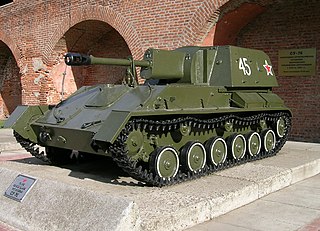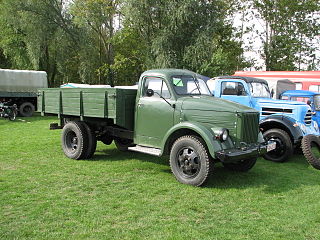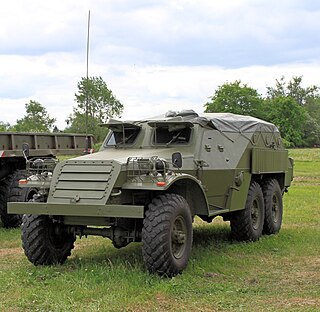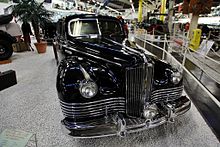
The Katyusha is a type of rocket artillery first built and fielded by the Soviet Union in World War II. Multiple rocket launchers such as these deliver explosives to a target area more intensively than conventional artillery, but with lower accuracy and requiring a longer time to reload. They are fragile compared to artillery guns, but are cheap, easy to produce, and usable on almost any chassis. The Katyushas of World War II, the first self-propelled artillery mass-produced by the Soviet Union, were usually mounted on ordinary trucks. This mobility gave the Katyusha, and other self-propelled artillery, another advantage: being able to deliver a large blow all at once, and then move before being located and attacked with counter-battery fire.

The SU-76 was a Soviet light self-propelled gun used during and after World War II. The SU-76 was based on a lengthened version of the T-70 light tank chassis and armed with the ZIS-3 mod. 1942 76-mm divisional field gun. Developed under the leadership of chief designer S.A. Ginzburg (1900–1943). Its quite simple construction and multipurpose combat role made it the second most produced Soviet armored fighting vehicle of World War II, after the T-34 medium tank.

Panzerkampfwagen VIII Maus was a German World War II super-heavy tank completed in July of 1944. It is the heaviest fully enclosed armored fighting vehicle ever built. Five were ordered, but only two hulls and one turret were completed, the turret being attached before the testing grounds were captured by advancing Soviet military forces.

The GAZ-51 was a Soviet truck manufactured by GAZ. Its first prototypes were produced before the end of World War II, and the truck ended up using a heavily modified version of the Studebaker US6 cab, which was supplied to the Soviet Union in large quantities with the Lend-Lease agreement, although the chassis was completely new.

The BTR-152 is a six-wheeled Soviet armored personnel carrier (APC) built on the chassis and drive train of a ZIS-151 utility truck. It entered service with a number of Warsaw Pact member states beginning in 1950, and formed the mainstay of Soviet motor rifle battalions until the advent of the amphibious BTR-60 series during the 1960s. BTR stands for bronetransportyor.

The ZIM-12 was a Soviet full-size luxury car produced by the Gorky Automotive Plant (GAZ) from 1950 until 1960. It was the first executive car produced by GAZ and the first one to have the famous leaping gazelle hood ornament. The car was built to serve high and medium rank Soviet nomenklatura, but was also readily available as a taxi and ambulance. Unlike its successors, ZIM was the only Soviet executive class full-size car that was actually made available for private ownership. A total of 21,527 examples were built.

OJSC AMO ZiL, known fully as the Public Joint-Stock Company – Likhachov Plant and more commonly called ZiL, was a major Russian automobile, truck, military vehicle, and heavy equipment manufacturer that was based in Moscow.

The M3 Scout Car was an American-produced armored car. The original M3 Scout Car was produced in limited numbers, while the improved M3A1 Scout Car saw wide service during World War II and after.

The BTR-70 is an eight-wheeled armored personnel carrier originally developed by the Soviet Union during the late 1960s under the manufacturing code GAZ-4905. On August 21, 1972, it was accepted into Soviet service and would later be widely exported. Large quantities were also produced under license in Romania as the TAB-77.

The ZIS-101 was a limousine produced by the Soviet car manufacturer Zavod Imeni Stalina. It was introduced in 1936. Its chassis was reverse-engineered from a Buick 33-90, except for the front suspension, engine, exhaust and battery carried over from 1933 experimental limousine L-1, itself an unlicensed Buick 32-90 copy, but the body was designed by Budd Company for $1,500,000 while the stamps were made by Hamilton Foundry & Machine Company for another $500,000. It was equipped with an 5.76 L (351 cu in) straight-eight OHV engine producing up to 110 PS (81 kW) and giving a top speed of 115 km/h (71 mph). The car was fitted with a 3-speed manual gearbox.

The ZIS-110 is a Soviet limousine from ZIL introduced in 1946.

The ZIL-114 is a limousine from the Soviet car manufacturer ZIL introduced in 1970 to replace the ZIL-111 series which was gradually becoming out of date. In almost all respects, the ZIL-114 improved on the 111, 111A and 111G models. The engine, a ZIL-built pushrod V8, was increased in capacity from 5,980 cc (364.9 cu in) to 6,959 cc (424.7 cu in), resulting in an increase of power by 30 percent and of maximum speed from approximately 170 km/h (110 mph) to 200 km/h (120 mph). Transmission was two-speed automatic, with hydraulic torque converter. A three-speed gearbox was offered beginning in April 1975.

The United States presidential state car is the official state car of the president of the United States.

The Packard Custom Super Eight One-Eighty was introduced for the 1940 model year by the Packard Motor Car Company to replace the discontinued Packard Twelve as their top-of-the-line luxury model. The car was derived from the Packard Super Eight One-Sixty with which it shared the complete running gear including the in-line eight-cylinder, 356-cubic-inch (5,830 cc) engine that developed 180 horsepower. It was advertised as the most powerful eight-cylinder engine offered by any automobile manufacturer in 1940.. It was complemented and gradually replaced by the more modern looking and mid-level Packard Clipper in 1941 and integrated into the Super Eight after the war.

The ZIS-151 was a general-purpose truck produced by the Soviet car manufacturer Automotive Factory No. 2 Zavod imeni Stalina in 1948–1958. In 1956, the factory was renamed to Zavod imeni Likhacheva, and new trucks were called ZIL-151 (ЗИЛ-151).

The GM "old-look" transit bus was a transit bus that was introduced in 1940 by Yellow Coach beginning with the production of the model TG-3201 bus. Yellow Coach was an early bus builder that was partially owned by General Motors (GM) before being purchased outright in 1943 and folded into the GM Truck Division to form the GM Truck & Coach Division. The Yellow Coach badge gave way to the GM nameplate in 1944. Production of most "old-look" models was stopped upon the release of the GM New-Look bus in 1959, however some smaller "old-look" models continued to be built until 1969. Approximately 38,000 "old-look" buses were built during the 29-year production run. The "old-look" name is an unofficial retronym applied to this series of GM buses after the release of the GM New-Look series.

The ZIL-4104 was a limousine built by ZIL from the late 1970s to the early 1980s, when it served as the transport of the elite of the Soviet Union. It is estimated that no more than fifty cars were produced each year.
An official state car is a vehicle used by a government to transport its head of state or head of government in an official capacity, which may also be used occasionally to transport other members of the government or visiting dignitaries from other countries. A few countries bring their own official state car for state visits to other countries, for instance, the United States, Russia, the United Kingdom, South Korea, Germany and Japan. It also may serve as an automotive symbol of the head of state and their country. An official state car must have adequate security, capability and stateliness for its duty. A limousine or other high-end vehicle is usually selected.

The ZIS-150 is a Soviet truck. In 1947 it replaced the ZIS-5 truck on the assembly line. Together with the GAZ-51, it was the main Soviet truck during the 1950s, judging by their quantity. A tractor-trailer version of the ZIS-150, the ZIS-120N was sold from 1956 to 1957. In 1957, the base ZIS-150 model was replaced by ZIL-164, which differed outwardly only by vertical grille bars and bumper.



















